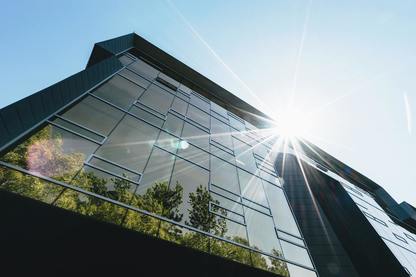|
Contributed by Emily Conner American’s spend more than 90% of their lives indoors. The majority of those daytime hours are set inside the office walls. Despite the rise of e-commerce and remote workers, most businesses still operate out of traditional, energy-hogging buildings. Collectively, our country’s building stock accounts for almost half of our annual total energy usage, 3/4s of our electricity consumption, and pumps out more than 39% of CO2 emissions produced in the U.S. The World Economic Forum also reports that the Engineering & Construction (E&C) industry is the nation’s single largest consumer of raw materials like steel. The Environmental and Energy Study Institute (EESI) predicts that, conservatively, by 2025 energy use in the business sector will cost more than $430 billion – about the same as our annual Medicare spend. Businesses have a major opportunity to reduce their environmental impact. Where do they begin? Easy. A better-built environment starts with a more sustainable building sector. We’ve collected some climate-friendly ways to make a positive contribution. But first, some quick business. Potential CO2 and Energy Savings The lifespan of an average building is 50-100 years. During that time, they produce tons of CO2 emissions every day. With new construction breaking records every year, we have the ability to make huge gains regarding energy efficiency. As ESSI points out, “If half of new commercial buildings were built to use 50% less energy, it would save over 6 million metric tons of CO2 annually for the life of the buildings—the equivalent of taking more than 1 million cars off the road every year.” So, there it is. Problem solved, right? New builds for everyone and our climate is saved? We think taking a more realistic course is a better plan of action. Building Better with Sustainable Solutions Let’s face it, not every business can afford to erect an entirely new LEED-certified green building and still have money to operate out of it. But there are ways businesses and construction companies both large and small can help transform the built environment. Though this list is by no means comprehensive, here are seven moves that can inch us toward a better-built building stock.
At its current scale, the challenge of our country’s inefficient building stock may seem insurmountable. However, with a little innovation and some uniformity in our practices, approaches like those listed above have the potential to help us use less energy. Not only that, intelligent buildings can lead the way for us as a nation make the transition to cleaner power sources that help instead of hurt our planet.
3 Comments
6/1/2021 03:18:17 am
It really helped when you said that businesses should implement energy-efficiency and renewable energy technologies to reduce their environmental impact. As you said, with little innovation and some uniformity in their methods, they can have the potential to use less energy. I guess businesses should consider getting environmental solutions for civil infrastructure to help save the environment.
Reply
7/27/2021 08:47:59 am
This is a good article. It is a combination of fun and informative. Thanks for sharing this!
Reply
7/30/2021 08:39:23 am
Stunning post! Thanks for the excellent presentation of your outline.
Reply
Leave a Reply. |
AboutLet's Fix Construction is an avenue to offer creative solutions, separate myths from facts and erase misconceptions about the architecture, engineering and construction (AEC) industry. Check out Cherise's latest podcast
Get blog post notifications hereArchives
March 2022
Categories
All
|


 RSS Feed
RSS Feed
